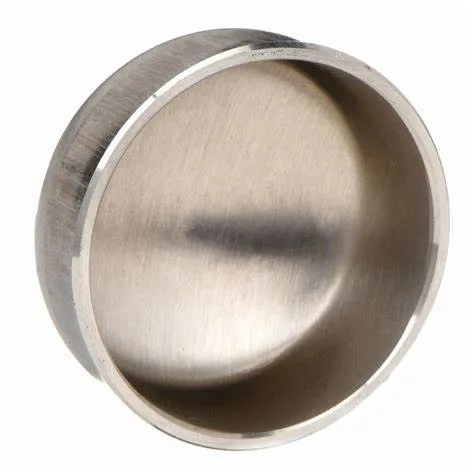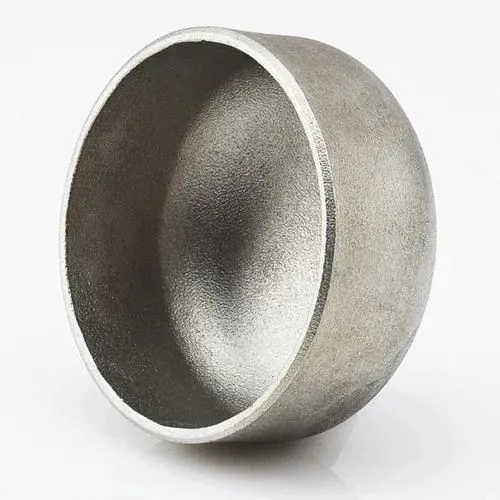JIS B2311 är en japansk industristandard som täcker stumsvetsande rördelar, inklusive lock som används i rörsystem. Stumsvetslock tjänar till att stänga änden av ett rör, vilket ger en tätning för att förhindra läckage eller kontaminering. Här är en introduktion till JIS B2311 stumsvetslock:
- 1. JIS B2311 Standard:
- - JIS B2311-standarden specificerar kraven för design, dimensioner, material, tillverkning och provning av stumsvetskopplingar, inklusive kapslar, i rörsystem.
- - Standarden säkerställer att lock tillverkade i enlighet med JIS-standarder uppfyller kvalitetsstandarder och är kompatibla med andra rörkomponenter.
- 2. Stumsvetsmössa:
- - Ett stumsvetslock, enligt JIS B2311, är en koppling som är utformad för att täcka och täta änden av ett rör på ett säkert sätt, vilket ger skydd och bibehåller rörsystemets integritet.
- - Kapslar används i situationer där röränden kräver förslutning, antingen permanent eller tillfälligt, för att förhindra läckage, kontaminering eller för att ge en finish till systemet.
- 3. Material och konstruktion:
- - Stumsvetslock enligt JIS B2311-specifikationer finns i olika material som kolstål, rostfritt stål och legerat stål för att möta olika applikationskrav.
- - Dessa lock är tillverkade med standardiserade konstruktionsmetoder för att säkerställa en stark och läckagefri anslutning när de svetsas mot änden av ett rör.
- 4. Ansökan och förmåner:
- - Stumsvetslock kan användas i olika industrier, inklusive olja och gas, kemiska processer, vattenreningsverk och mer där rörändar måste täckas ordentligt.
- - Kapslar ger skydd till rörändar från miljöfaktorer, förhindrar kontaminering och hjälper till att upprätthålla renheten och integriteten hos rörsystemet.
- 5. Installation och svetsning:
- - Korrekt installationspraxis, inklusive korrekt inriktning, förberedelse av röränden och svetstekniker, är väsentliga när du installerar stumsvetslock för att säkerställa en tät och läckagesäker tätning.
- - Svetsning är en vanlig metod för att fästa lock på rör, vilket ger en säker och permanent förslutning som tål tryck, temperaturvariationer och vätskeflöde i systemet.
- Sammanfattningsvis är JIS B2311 stumsvetshuvar avgörande komponenter som används i rörsystem för att täta och skydda änden av rören på ett säkert sätt. Dessa lock överensstämmer med standardiserade krav för att säkerställa kvalitet, tillförlitlighet och kompatibilitet inom industriella applikationer där rörförslutning och skydd är nödvändigt.
What Is a Butt Welding Cap and How Is It Used in Industrial Piping?
In industrial piping systems, end-of-line sealing and branch closures require robust solutions. A butt welding cap serves as a critical component for terminating pipes securely. By providing a seamless, welded closure, this fitting maintains system integrity, prevents leaks, and supports compliance with industry standards.
What Is a Butt Welding Cap?
A butt welding cap—also called a pipe end cap or buttweld end cap—is a round fitting designed to close off the end of a pipe. It’s manufactured to match the pipe’s outer diameter and schedule, with either a hemispherical or flat face. To install, both the pipe end and cap are beveled to form a V‑groove, enabling full‑penetration, fusion welds. Common materials include carbon steel, stainless steel, nickel alloys, and other engineered grades, chosen to satisfy pressure, temperature, and corrosion‑resistance requirements.
How Is Butt Welding Cap Used in Industrial Piping?
Butt welding caps find application across oil & gas, petrochemical, power generation, water treatment, and general process industries for both permanent and temporary closures. During hydrostatic testing, technicians install caps to seal off sections of piping while monitoring for leaks. In new construction or retrofit projects, caps terminate branch lines, future tie‑in spools, or dead‑end mains until system expansion. Welders prepare each joint by cleaning and beveling surfaces, aligning the cap precisely, and executing a root pass followed by filler passes per the qualified Welding Procedure Specification (WPS). Post‑weld heat treatment and non‑destructive examination (NDE)—such as radiography or ultrasonic testing—verify weld integrity and compliance with ASME B16.9 and related standards. Additionally, temporary caps enable safe isolation during maintenance, allowing for segment testing and dewatering under regulatory protocols.
Benefits and Best Practices
Butt welding caps offer a smooth‑bore transition that minimizes flow disruption and stress concentration. Their full‑penetration welds deliver exceptional structural strength and leak resistance. To optimize performance, engineers should:
Select caps with matching material grades and wall thicknesses
Adhere to proper bevel angles and joint fit‑up tolerances
Follow qualified WPS protocols rigorously
Consider cladding or protective coatings in corrosive environments to extend service life
Regular inspection and thorough documentation ensure long‑term reliability and safe operation under demanding conditions.
Butt welding caps are indispensable components for achieving durable, leak‑proof pipe terminations in a wide range of industrial applications.
Butt Welding Cap FAQs
What is a butt welding cap?
|
What materials are commonly used?
|
What standards govern butt welding caps?
|
How are butt welding caps installed?
|
Where are butt welding caps typically used?
|
What are the advantages of threaded caps?
|
















